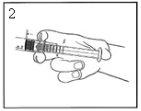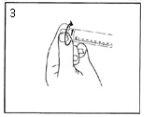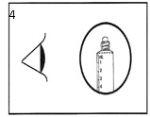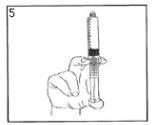

ФЕНИЛЕФРИН АГУЭТТАН 50 микрограммов/мл раствор для инъекций в предварительно заполненном шприце

Спросите врача о рецепте на ФЕНИЛЕФРИН АГУЭТТАН 50 микрограммов/мл раствор для инъекций в предварительно заполненном шприце

Инструкция по применению ФЕНИЛЕФРИН АГУЭТТАН 50 микрограммов/мл раствор для инъекций в предварительно заполненном шприце
Введение
Инструкция: информация для пациента
Фенилэфрин Aguettant 50 микрограммов/мл раствор для инъекций в предварительно заполненном шприце
(Далее по тексту«Фенилэфрин для инъекций»)
Фенилэфрин
Прочитайте внимательно всю инструкцию перед тем, каквам будет введено это лекарство, поскольку оно содержит важную информацию для вас.
- Сохраните эту инструкцию, поскольку вам может понадобиться прочитать ее снова. Если у вас есть какие-либо вопросы, проконсультируйтесь с вашим врачом, фармацевтом или медсестрой.
- Если вы испытываете побочные эффекты, проконсультируйтесь с вашим врачом, фармацевтом или медсестрой, даже если это побочные эффекты, которые не указаны в этой инструкции. См. раздел 4.
Содержание инструкции
- Что такое Фенилэфрин для инъекций и для чего он используется
- Что вам нужно знать перед тем, как вам будет введен Фенилэфрин для инъекций
- Как вводится Фенилэфрин для инъекций
- Возможные побочные эффекты
- Хранение Фенилэфрина для инъекций
- Содержание упаковки и дополнительная информация
1. Что такое Фенилэфрин для инъекций и для чего он используется
Это лекарство относится к группе адренергических и дофаминергических средств.
Он используется для лечения низкого артериального давления во время анестезии.
2. Что вам нужно знать перед тем, как вам будет введен Фенилэфрин для инъекций
Вам не будет введен Фенилэфрин для инъекций:
- Если вы аллергичны к гидрохлориду фенилэфрина или к любому другому компоненту этого лекарства (указанному в разделе 6);
- Если у вас чрезвычайно высокое артериальное давление или периферическое сосудистое заболевание (плохая циркуляция);
- Если вы принимаете ингибитор моноаминоксидазы (ИМАО) (или в течение 2 недель после его отмены), используемый для лечения депрессии (такой как ипрониязид, ниаламид);
- Если у вас есть чрезвычайно гиперактивная щитовидная железа (гипертиреоз).
Предостережения и меры предосторожности
Проконсультируйтесь с вашим врачом, фармацевтом или медсестрой перед началом использования Фенилэфрина для инъекций:
- Если вы пожилой человек;
- Если у вас диабет;
- Если у вас артериальная гипертония;
- Если у вас гиперактивная щитовидная железа (неконтролируемый гипертиреоз);
- Если у вас есть заболевание кровеносных сосудов, такое как атеросклероз (уплотнение и утолщение стенок кровеносных сосудов);
- Если у вас плохая циркуляция крови в мозге;
- если у вас сердечное заболевание, включая хронические заболевания сердца, периферическую сосудистую недостаточность, нарушения сердечного ритма, тахикардию (учащенное сердцебиение), брадикардию (замедленное сердцебиение), частичный блок сердца, стенокардию;
- Если у вас есть глаукома с закрытым углом (редкое заболевание глаз).
У пациентов с тяжелой сердечной недостаточностью фенилэфрин может ухудшить сердечную недостаточность из-за сужения кровеносных сосудов.
Ваше артериальное давление будет контролироваться во время лечения. Если у вас есть сердечное заболевание, будет проводиться дополнительный контроль ваших жизненно важных функций.
Дети
Не рекомендуется использовать это лекарство у детей из-за недостаточных данных о его эффективности, безопасности и рекомендациях по дозировке.
Использование Фенилэфрина для инъекций с другими лекарствами
Сообщите вашему врачу, если вы используете, недавно использовали или можете использовать любое другое лекарство, такое как:
- некоторые антидепрессанты (ипрониязид, ниаламид, моклобемид, толоксатон, имипрамин, милнаципран или венлафаксин);
- лекарства, используемые для лечения инфекций (линезолид);
- некоторые лекарства, используемые для лечения мигрени (дигидроэрготамин, эрготамин, метилэргометрин, метисергид);
- некоторые лекарства, используемые для лечения болезни Паркинсона (бромокриптин, лисурид, перголид);
- лекарство, используемое для подавления производства гормона, ответственного за лактацию (каберголин);
- ингаляционная анестезия (десфлуран, энфлуран, галотан, изофлуран, метоксифлуран, севофлуран);
- лекарства, используемые в качестве подавителей аппетита (сибутрамин);
- лекарства, используемые для лечения артериальной гипертонии (гуанетидин);
- лекарства, используемые для лечения сердечной недостаточности и некоторых аритмий (кардиальные гликозиды);
- лекарства, используемые для лечения нарушений сердечного ритма (хинидин);
- лекарства, используемые во время родов (окситоцин).
Беременность и лактация
Не установлена безопасность этого лекарства во время беременности и лактации, но использование Фенилэфрина для инъекций возможно во время беременности, если это необходимо.
Не рекомендуется использовать это лекарство во время лактации. Однако лактация возможна, если лекарство вводится один раз во время родов.
Если вы беременны или кормите грудью, считаете, что можете быть беременной или планируете стать беременной, проконсультируйтесь с вашим врачом, фармацевтом или медсестрой перед использованием этого лекарства.
Вождение и использование машин
Поговорите с вашим врачом, если вы хотите водить или использовать машины после использования этого лекарства.
Фенилэфрин для инъекций содержит натрий
Это лекарство содержит 37,2 мг натрия (основного компонента поваренной соли) в каждом шприце. Это эквивалентно 1,9% от максимальной рекомендуемой суточной нормы потребления натрия для взрослого.
3. Как вводится Фенилэфрин для инъекций
Введение будет осуществляться квалифицированным медицинским специалистом, который решит, какая доза подходит вам и когда и как должна быть введена инъекция.
Рекомендуемые дозы:
Использование у взрослых
Ваш врач определит дозу, которая будет введена, и может быть повторена или скорректирована до достижения желаемого эффекта.
Использование у пациентов с почечной недостаточностью(почки не функционируют хорошо)
Может потребоваться более низкая доза фенилэфрина у пациентов с почечной недостаточностью.
Использование у пациентов с печеночной недостаточностью(печень не функционирует хорошо)
Пациенты с циррозом печени могут потребовать более высокой дозы фенилэфрина.
Использование у пожилых пациентов
Лечение у пожилых людей должно проводиться с осторожностью.
Использование у детей
Не рекомендуется использовать это лекарство у детей из-за недостаточных данных о его эффективности, безопасности и рекомендациях по дозировке.
Если вам было введено больше Фенилэфрина для инъекций, чем должно быть:
У вас могут быть следующие симптомы: сердцебиение, нарушения сердечного ритма (тахикардия, аритмии).
Для получения более подробной информации об использовании этого лекарства проконсультируйтесь с вашим врачом, фармацевтом или медсестрой.
4. Возможные побочные эффекты
Как и все лекарства, это лекарство может вызывать побочные эффекты, хотя не все люди испытывают их.
Некоторые побочные эффекты могут быть тяжелыми (частота неизвестна). Сообщите вашему врачу немедленно, если вы испытываете любой из этих симптомов:
- боль в груди или боль из-за стенокардии;
- нарушения сердечного ритма;
- чувство, что сердце выпрыгивает из груди;
- кровоизлияние в мозг (нарушение речи, головокружение, паралич одной стороны тела);
- психоз (потеря контакта с реальностью);
Другие побочные эффекты могут включать (частота неизвестна):
- реакция гиперчувствительности (аллергия);
- чрезмерное расширение зрачков;
- увеличение внутриглазного давления (ухудшение глаукомы);
- возбудимость (чрезмерная чувствительность органа или части тела);
- агитация (беспокойство);
- тревога;
- спутанность сознания;
- головная боль;
- нервозность;
- бессонница (трудности с засыпанием или поддержанием сна);
- дрожь;
- жжение кожи;
- зуд кожи;
- зуд или ощущение онемения кожи (парестезия);
- замедленный или учащенный сердечный ритм;
- артериальная гипертония;
- затруднение дыхания;
- жидкость в легких;
- тошнота;
- рвота;
- пот;
- бледность кожи (бледный цвет кожи);
- гусиная кожа;
- повреждение ткани в месте инъекции;
- слабость мышц;
- затруднение мочеиспускания или задержка мочи.
Сообщение о побочных эффектах
Если вы испытываете любой побочный эффект, проконсультируйтесь с вашим врачом, фармацевтом или медсестрой, даже если это возможные побочные эффекты, которые не указаны в этой инструкции. Вы также можете сообщить об этом напрямую через систему фармаковигиланса: https://www.notificaram.es. Сообщая о побочных эффектах, вы можете внести свой вклад в предоставление более подробной информации о безопасности этого лекарства.
5. Хранение Фенилэфрина для инъекций
Храните это лекарство в недоступном для детей месте.
Не используйте это лекарство после истечения срока годности, указанного на упаковке и этикетке шприца после «Срок годности». Срок годности - последний день месяца, указанного.
Это лекарство не требует специальных условий хранения.
Храните блистер в наружной упаковке, чтобы защитить его от света. Храните шприц в блистере, плотно закрытом.
Не используйте это лекарство, если вы заметили видимые признаки его порчи.
Любой шприц, даже если он был использован только частично, должен быть утилизирован после использования.
Лекарства не должны выбрасываться в канализацию или мусор. Спросите вашего фармацевта, как утилизировать упаковку и лекарства, которые вам больше не нужны. Таким образом, вы поможете защитить окружающую среду.
6. Содержание упаковки и дополнительная информация
Состав Фенилэфрина для инъекций
Активное вещество - гидрохлорид фенилэфрина.
- Каждый мл раствора для инъекций содержит гидрохлорид фенилэфрина, эквивалентный 50 микрограммам фенилэфрина.
- Каждый предварительно заполненный шприц объемом 10 мл содержит гидрохлорид фенилэфрина, эквивалентный 500 микрограммам фенилэфрина.
- Другие компоненты - хлорид натрия, цитрат натрия, моногидрат лимонной кислоты, гидроксид натрия и вода для инъекций.
Внешний вид продукта и содержание упаковки
Фенилэфрин для инъекций - прозрачный бесцветный раствор в предварительно заполненном шприце из полипропилена объемом 10 мл, упакованный индивидуально в прозрачный блистер.
Предварительно заполненные шприцы поставляются в упаковках по 1 и 10 шприцев.
Может быть, что только некоторые размеры упаковок будут продаваться.
Владелец разрешения на маркетинг и ответственный за производство
LABORATOIRE AGUETTANT
1 rue Alexander Fleming, Parc Scientifique Tony Garnier
69007 Lyon- Франция
Laboratoire AGUETTANT
Lieu-Dit « Chantecaille »
07340 Champagne
Франция
Местный представитель:
AGUETTANT IBERICA
C/Pau claris, 139, Pral. 2
08009, Барселона-Испания
Дата последнего обновления этой инструкции:Сентябрь 2020
Подробная и актуальная информация о этом лекарстве доступна на сайте Агентства по лекарственным средствам и медицинским изделиям (AEMPS) http://www.aemps.gob.es/
Эта информация предназначена только для медицинских специалистов:
Подготовьте шприц тщательно, как указано ниже
Предварительно заполненный шприц предназначен для одного пациента. Утилизируйте шприц после использования. Не повторно используйте.
Содержимое блистера, который не открыт и не поврежден, стерильно и не должно быть открыто до момента использования.
Продукт должен быть визуально осмотрен, чтобы проверить, нет ли частиц или изменения цвета перед введением. Можно использовать только раствор, если он прозрачный, бесцветный и свободный от частиц или осадков.
Продукт не должен быть использован, если упаковка шприца повреждена.
Внешняя поверхность шприца стерильна до тех пор, пока блистер не будет открыт.
При использовании асептического метода Фенилэфрин Aguettant 50 микрограммов/мл раствор для инъекций в предварительно заполненном шприце может быть помещен в стерильное поле.
- Выньте предварительно заполненный шприц из стерильного блистера.
|
|
|
|
|
|
|
|
- Подключите шприц к внутривенному доступу. Нажмите на поршень медленно, чтобы ввести необходимый объем.
- Утилизация неиспользованного лекарства или материалов для утилизации должна быть проведена в соответствии с местными требованиями.
- Страна регистрации
- Активное вещество
- Требуется рецептДа
- Производитель
- Информация носит справочный характер и не является медицинской рекомендацией. Перед приемом любых препаратов проконсультируйтесь с врачом. Oladoctor не несет ответственности за медицинские решения, принятые на основе этого контента.
- Аналоги ФЕНИЛЕФРИН АГУЭТТАН 50 микрограммов/мл раствор для инъекций в предварительно заполненном шприцеФорма выпуска: ИНЪЕКЦИОННЫЙ РАСТВОР, 100 микрограмм/млАктивное вещество: фенилэфринаПроизводитель: Laboratoire AguettantТребуется рецептФорма выпуска: ИНЪЕКЦИОННЫЙ РАСТВОР, 0,1 мг/млАктивное вещество: фенилэфринаПроизводитель: Altan Pharmaceuticals SaТребуется рецептФорма выпуска: ИНЪЕКЦИОННЫЙ РАСТВОР, 10 мг/млАктивное вещество: фенилэфринаПроизводитель: Altan Pharmaceuticals SaТребуется рецепт
Аналоги ФЕНИЛЕФРИН АГУЭТТАН 50 микрограммов/мл раствор для инъекций в предварительно заполненном шприце в других странах
Лучшие аналоги с тем же действующим веществом и терапевтическим эффектом.
Аналог ФЕНИЛЕФРИН АГУЭТТАН 50 микрограммов/мл раствор для инъекций в предварительно заполненном шприце в Польша
Аналог ФЕНИЛЕФРИН АГУЭТТАН 50 микрограммов/мл раствор для инъекций в предварительно заполненном шприце в Украина
Врачи онлайн по ФЕНИЛЕФРИН АГУЭТТАН 50 микрограммов/мл раствор для инъекций в предварительно заполненном шприце
Консультация по дозировке, побочным эффектам, взаимодействиям, противопоказаниям и продлению рецепта на ФЕНИЛЕФРИН АГУЭТТАН 50 микрограммов/мл раствор для инъекций в предварительно заполненном шприце – по решению врача и с учетом местных правил.














